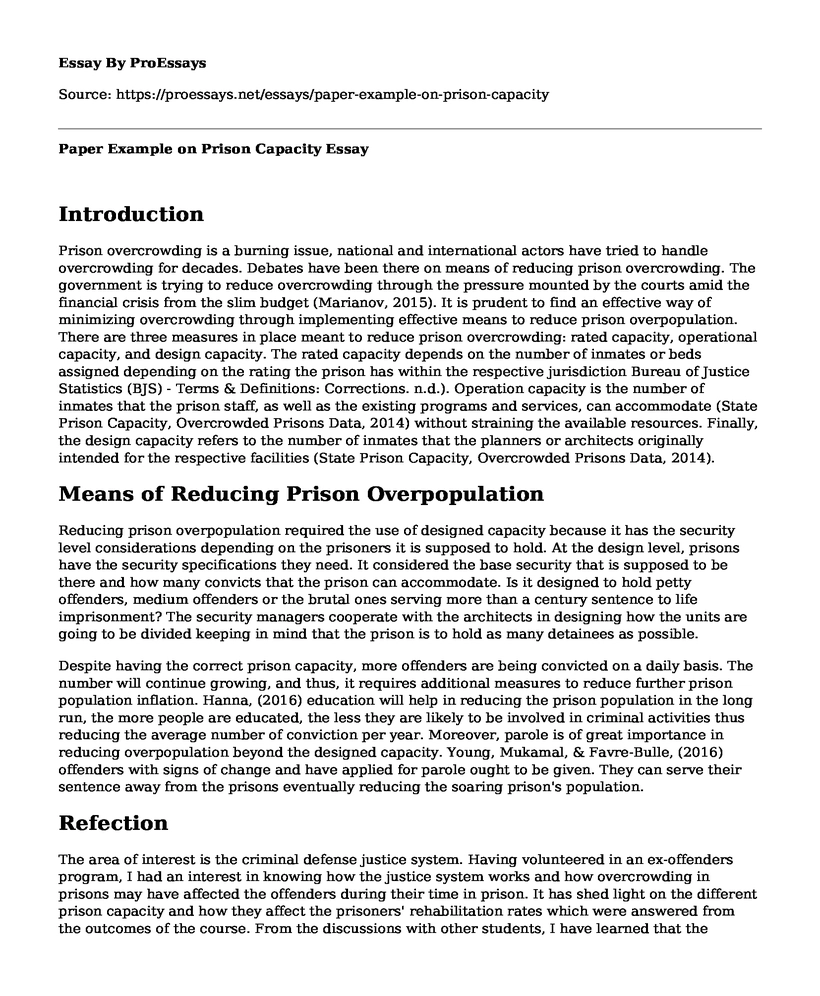Introduction
Prison overcrowding is a burning issue, national and international actors have tried to handle overcrowding for decades. Debates have been there on means of reducing prison overcrowding. The government is trying to reduce overcrowding through the pressure mounted by the courts amid the financial crisis from the slim budget (Marianov, 2015). It is prudent to find an effective way of minimizing overcrowding through implementing effective means to reduce prison overpopulation. There are three measures in place meant to reduce prison overcrowding: rated capacity, operational capacity, and design capacity. The rated capacity depends on the number of inmates or beds assigned depending on the rating the prison has within the respective jurisdiction Bureau of Justice Statistics (BJS) - Terms & Definitions: Corrections. n.d.). Operation capacity is the number of inmates that the prison staff, as well as the existing programs and services, can accommodate (State Prison Capacity, Overcrowded Prisons Data, 2014) without straining the available resources. Finally, the design capacity refers to the number of inmates that the planners or architects originally intended for the respective facilities (State Prison Capacity, Overcrowded Prisons Data, 2014).
Means of Reducing Prison Overpopulation
Reducing prison overpopulation required the use of designed capacity because it has the security level considerations depending on the prisoners it is supposed to hold. At the design level, prisons have the security specifications they need. It considered the base security that is supposed to be there and how many convicts that the prison can accommodate. Is it designed to hold petty offenders, medium offenders or the brutal ones serving more than a century sentence to life imprisonment? The security managers cooperate with the architects in designing how the units are going to be divided keeping in mind that the prison is to hold as many detainees as possible.
Despite having the correct prison capacity, more offenders are being convicted on a daily basis. The number will continue growing, and thus, it requires additional measures to reduce further prison population inflation. Hanna, (2016) education will help in reducing the prison population in the long run, the more people are educated, the less they are likely to be involved in criminal activities thus reducing the average number of conviction per year. Moreover, parole is of great importance in reducing overpopulation beyond the designed capacity. Young, Mukamal, & Favre-Bulle, (2016) offenders with signs of change and have applied for parole ought to be given. They can serve their sentence away from the prisons eventually reducing the soaring prison's population.
Refection
The area of interest is the criminal defense justice system. Having volunteered in an ex-offenders program, I had an interest in knowing how the justice system works and how overcrowding in prisons may have affected the offenders during their time in prison. It has shed light on the different prison capacity and how they affect the prisoners' rehabilitation rates which were answered from the outcomes of the course. From the discussions with other students, I have learned that the rehabilitation rates depend on the environment the prisoners have been put. The knowledge gained will help me when furthering my volunteer ship in inmates rehabilitation and the fight for favorable condition provision. There is so much to be improved especially in crime reduction which will, in turn, be reflected in the reduced number of prisoners. However, it raises questions if the government is doing enough to reduce the crime rates. I would like to further on criminal justice to ensure that not only justice will be served but also the reduction of the crime rates.
References
Albrecht, H. J. (2010). Prison overcrowding-finding effective solutions. Strategies and Best Practices Against Overcrowding in Correctional Facilities. www.unafei.or.jp/english/pdf/Congress_2010/13Hans-Jorg_Albrecht.pdf
Bureau of Justice Statistics (BJS) - Terms & Definitions: Corrections. (n.d.). Retrieved from https://www.bjs.gov/index.cfm?ty=tdtp&tid=1
Hanna, P. (2016). Human Cattle: Prison Overpopulation and the Political Economy of Mass Incarceration. Themis: Research Journal of Justice Studies and Forensic Science, 4(1), 3. http://scholarworks.sjsu.edu/themis/vol4/iss1/3
Marianov, V. (2015). Location and Sizing of Prisons and Inmate Allocation. In Applications of Location Analysis (pp. 349-368). Springer, Cham. DOI: 10.1007/978-3-319-20282-2_15
Singer, G. (2017). Prison libraries inside out. Education libraries, 24(1), 11-16. DOI: http://dx.doi.org/10.26443/el.v24i1.151State Prison Capacity, Overcrowded Prisons Data. (2014). Retrieved from http://www.governing.com/gov-data/safety-justice/state-prison-capacity-overcrowding-data.html
Young, K. M., Mukamal, D. A., & Favre-Bulle, T. (2016). Predicting Parole Grants: An Analysis of Suitability Hearings for California's Lifer Inmates. Federal Sentencing Reporter, 28(4), 268-277. DOI: 10.1525/fsr.2016.28.4.268
Cite this page
Paper Example on Prison Capacity. (2022, Jun 06). Retrieved from https://proessays.net/essays/paper-example-on-prison-capacity
If you are the original author of this essay and no longer wish to have it published on the ProEssays website, please click below to request its removal:
- Research Paper on Federal Bureau of Investigation
- Women Finally Speak: Oprah's Speech Analysis
- Administrative Law Memorandum - Essay Sample
- Effect of Architecture in Reducing Crimes - Research Paper
- Testing on Human Vs Testing on Animals Essay Example
- Marijuana Legalization: Changing Attitudes and Trends in the US - Research Paper
- Essay on Struggle for Voting Rights: Analyzing the 'Bridge to Freedom' Episode in Eye on the Prize Series







